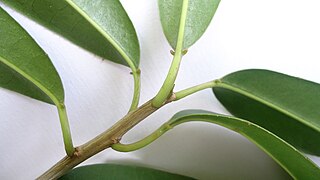
Sapium is a genus of flowering plants in the family Euphorbiaceae. It is widespread across most of Latin America and the West Indies. Many Old World species were formerly included in the genus, but recent authors have redistributed all the Old World species into other genera.

Psidium is a genus of trees and shrubs in the family Myrtaceae. It is native to warmer parts of the Western Hemisphere.

Tabernaemontana is a genus of flowering plants in the family Apocynaceae. It has a pan-tropical distribution, found in Asia, Africa, Australia, North America, South America, and a wide assortment of oceanic islands. These plants are evergreen shrubs and small trees growing to 1–15 m tall. The leaves are opposite, 3–25 cm long, with milky sap; hence it is one of the diverse plant genera commonly called "milkwood". The flowers are fragrant, white, 1–5 cm in diameter.

Mandevilla is a genus of tropical and subtropical flowering vines belonging to the family Apocynaceae. It was first described as a genus in 1840. A common name is rocktrumpet.
Conceveiba is a plant genus of the family Euphorbiaceae, first described as a genus in 1775. It is native to South America and Central America.
- Conceveiba guianensisAubl. - Brazil, Peru, Bolivia, Ecuador, Colombia, Venezuela, 3 Guianas
- Conceveiba hostmaniiBenth. - Guyana, Suriname, Amazonas State in Brazil
- Conceveiba krukoffiiSteyerm. - Venezuela, French Guiana, NW Brazil
- Conceveiba latifoliaBenth. - Colombia, Venezuela, Peru, Amazonas State in Brazil
- Conceveiba martianaBaill. - Venezuela, French Guiana, NW Brazil, Colombia, Ecuador, Peru, Bolivia
- Conceveiba maynasensisSecco - Loreto in Peru
- Conceveiba parvifoliaMcPherson - Panama, NW Colombia
- Conceveiba pleiostemonaDonn.Sm. - Costa Rica, Nicaragua, Colombia, Venezuela
- Conceveiba praealta(Croizat) Punt ex J.Murillo - NW Brazil
- Conceveiba ptariana(Steyerm.) Jabl. - S Venezuela
- Conceveiba rhytidocarpaMüll.Arg. - Colombia, Ecuador, Peru
- Conceveiba santanderensisJ.Murillo - NW Colombia
- Conceveiba terminalis(Baill.) Müll.Arg. - Venezuela, Guyana, Suriname, NW Brazil, Colombia, Peru
- Conceveiba tristigmataJ.Murillo - Colombia, Venezuela, NW Brazil

Chaetocarpus is a plant genus of the family Peraceae, formerly Euphorbiaceae, first described as a genus in 1854. Chaetocarpus species are trees or shrubs. They are native to the Americas, Africa, and Asia. Some species are endangered.
- Chaetocarpus acutifolius(Britton & P.Wilson) Borhidi - Sierra de Moa in Cuba
- Chaetocarpus africanusPax - C Africa
- Chaetocarpus castanocarpus(Roxb.) Thwaites - SE Asia, Yunnan, Assam, Bangladesh, Sri Lanka
- Chaetocarpus cordifolius(Urb.) Borhidi - Cuba, Hispaniola, Jamaica
- Chaetocarpus coriaceusThwaites - Sri Lanka
- Chaetocarpus cubensisFawc. & Rendle - Cuba
- Chaetocarpus echinocarpus (Baill.) Ducke - Bolivia, Brazil
- Chaetocarpus ferrugineusPhilcox - Sri Lanka
- Chaetocarpus gabonensisBreteler - Gabon
- Chaetocarpus globosus(Sw.) Fawc. & Rendle - Jamaica, Cuba, Dominican Rep.
- Chaetocarpus myrsinitesBaill. - Bolivia, Brazil
- Chaetocarpus parvifoliusBorhidi - Cuba
- Chaetocarpus pearceiRusby - Bolivia
- Chaetocarpus pubescens(Thwaites) Hook.f. - Sri Lanka
- Chaetocarpus rabarabaCapuron - Madagascar
- Chaetocarpus schomburgkianus(Kuntze) Pax & K.Hoffm. - Colombia, Venezuela, 3 Guianas, NW Brazil

Dalechampia is a genus of plant of the family Euphorbiaceae and of the monogeneric subtribe Dalechampiinae. It is widespread across lowland tropical areas primarily in the Americas with smaller numbers of species in Africa, Madagascar, and southern Asia. Additional new species are still being described and several are very rare and at risk of extinction.

Mabea is a plant genus of the family Euphorbiaceae first described in 1775. It is native to Central and South America as well as Mexico and Trinidad.
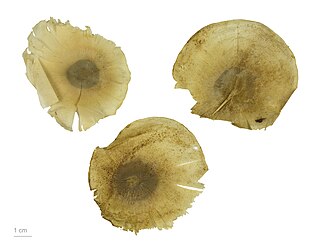
Aspidosperma is a genus of flowering plant in the family Apocynaceae, first described as a genus in 1824. It is native to South America, Central America, southern Mexico, and the West Indies.

Oenocarpus is a genus of pinnate-leaved palms (Arecaceae) native to Trinidad, southern Central and tropical South America. With nine species and one natural hybrid, the genus is distributed from Costa Rica and Trinidad in the north to Brazil and Bolivia in the south.

Micropholis is group of trees in the family Sapotaceae, described as a genus in 1891.
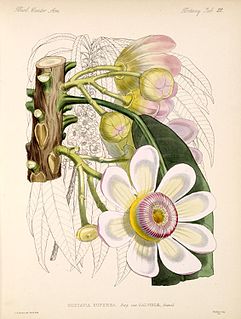
Gustavia is a genus of flowering plants in the family Lecythidaceae described by Linnaeus in 1775. It is native to tropical Central America and South America. Many of the species are threatened; some are critically endangered Gustavia superba, though, is actually abundant in re-growing secondary forests. It grows in northern South America, from Panama south through the Andes as far as Ecuador, and along the Caribbean coast and in the Amazon basin. Gustavia flowers have numerous stamens, in some species as many as 1,200 in a single flower.
Forsteronia is a genus of plants in the family Apocynaceae, first described as a genus in 1818. It is native to South America, Central America, Mexico, and the West Indies.
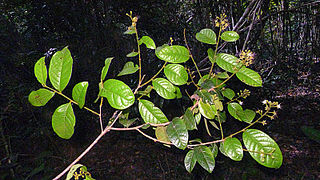
Hirtella is a genus of 110 species of woody trees in family Chrysobalanaceae. It was first described as a genus by Linnaeus in 1753. Hirtella naturally occurs in tropical forests throughout Latin America, the West Indies, southeast Africa, and Madagascar. The flowers are mainly pollinated by butterflies.

Monotagma is a genus of plant in family Marantaceae described as a genus in 1902. It is native to tropical America.

Couepia is a genus of flowering plants in the family Chrysobalanaceae described as a genus in 1775.
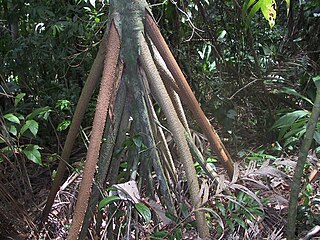
Socratea is a genus of five species of palms found in tropical Central America and South America.

Olyra is a genus of tropical bamboos in the grass family. It is native primarily to the Western Hemisphere, with one species extending into Africa.

Ischnosiphon is a genus of plants native to Central America, South America, Trinidad and the Lesser Antilles. It was first described as a genus in 1859.

Lacmellea is a genus of flowering plants in the family Apocynaceae first described as a genus in 1857. It is native to South America and Central America.
- Lacmellea abbreviataJ.F.Morales - Colombia
- Lacmellea aculeata(Ducke) Monach - Peru, NW Brazil, the Guianas
- Lacmellea arborescens(Müll.Arg.) Markgr. - Brazil, Bolivia
- Lacmellea bahiensisJ.F.Morales - Bahia
- Lacmellea costanensisSteyerm. - N Venezuela
- Lacmellea densifoliata(Ducke) Markgr. - Pará
- Lacmellea edulisH.Karst. - Panama, Venezuela, Colombia, Ecuador, Peru, Brazil
- Lacmellea floribunda(Poepp.) Benth. & Hook.f. - Peru, NW Brazil, Suriname, French Guiana
- Lacmellea foxii(Stapf) Markgr. - Peru
- Lacmellea gracilis(Müll.Arg.) Markgr. - N Peru, NW Brazil
- Lacmellea guyanensis(Müll.Arg.) Monach - French Guiana
- Lacmellea klugiiMonach. - Peru
- Lacmellea macranthaJ.F.Morales - Ecuador
- Lacmellea microcarpa(Müll.Arg.) Markgr. - Colombia, S Venezuela, NW Brazil
- Lacmellea oblongataMarkgr. - SE Colombia, Ecuador, Peru
- Lacmellea panamensis(Woodson) Markgr. - Costa Rica, Panama, Colombia, Ecuador
- Lacmellea pauciflora(Kuhlm.) Markgr. - Brazil
- Lacmellea peruviana(Van Heurck & Müll.Arg.) Markgr. - Peru
- Lacmellea pygmaeaMonach. - Amazonas State in Venezuela
- Lacmellea ramosissima(Müll.Arg.) Markgr. - Colombia, S Venezuela, NW Brazil
- Lacmellea speciosaWoodson - Costa Rica, Panama, Colombia, Ecuador, Peru
- Lacmellea standleyi(Woodson) Monach. - Belize, Guatemala, Honduras
- Lacmellea utilis(Arn.) Markgr. - S Venezuela, Guyana
- Lacmellea zamoraeJ.F.Morales - Costa Rica


















